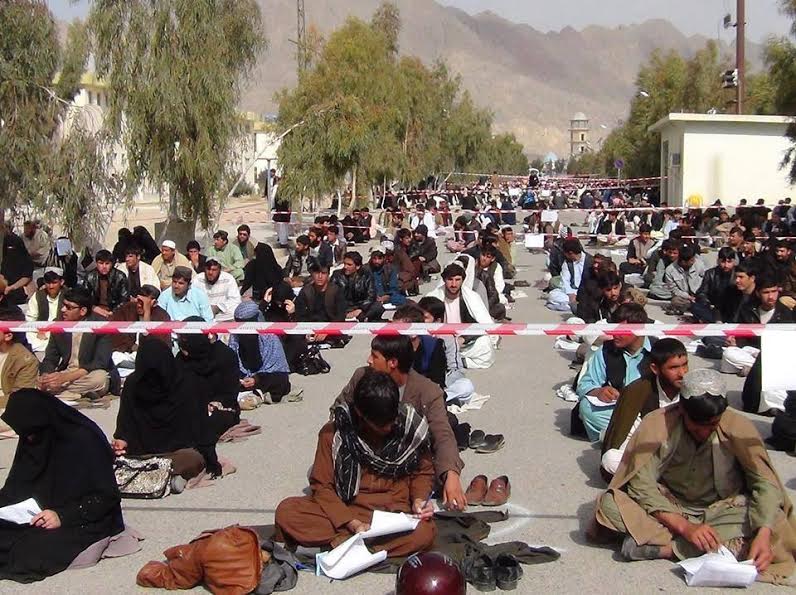Although the total number of participants in the National University Entrance Exam (Konkur) in 1403 has decreased significantly compared to four years ago due to the ban on girls’ education, a closer examination of recent years reveals that the pattern of participation in the entrance exam has changed dramatically among provinces. Compared to previous years, the southern and eastern provinces of the country have experienced a significant increase in the number of candidates for the entrance exam, while the central provinces and major cities such as Kabul, Herat, Daikundi, Bamyan, Balkh, and Ghazni have seen a marked decline.

The “Kabul Perspective” report compares the number of entrance exam candidates from various provinces in the years 1400 (2021) and 1403 (2024), providing an overview of the differences between the entrance exams conducted under Taliban rule and those held during the republican regime.
The comparison of participant percentages from different provinces against the total number of entrance exam candidates in these two years indicates that provinces such as Kandahar, Paktika, Nangarhar, and Paktia have seen a significant increase in student participation, nearly doubling their proportions compared to other provinces.
For instance, in Paktia during the current year, 2,167 individuals participated in the entrance exam, accounting for 2.54% of the total participants nationwide; three years ago, during the final months of the republican regime, this figure was only 1.64%. In Paktika, participation increased from 0.57% in 1400 to 0.94% in 1403. Similarly, statistics show that participation in Nangarhar rose from 7% of national candidates in 1400 to 10.5% in 1403. In Logar, participation increased from 1.6% to 2.6%, while Khost saw an increase from 2.7% to 3.6%. Kandahar’s Kankur exam participants rose from 1.8% in 1400 to 2% in 1403. Other southern and eastern provinces such as Zabul, Helmand, and Laghman have experienced a limited decrease in entrance exam participants due to the ban on girls’ education this year. When compared to the last year of the republican regime, these provinces have also risen their share nationwide.
In contrast, students from Herat and Balkh constituted only 2.7% and 4.7% of Kankur participants, respectively, in 1403. In comparison, these figures were 5.2% and 7% in 1400.
The findings indicate that participation in the national entrance exam has significantly decreased in Kabul (the capital), Ghazni, Daikundi, and Bamiyan. In Kabul, the percentage of Kankur participants dropped from 25% of national candidates in 1400 to 21% in 1403. This decline was more pronounced in the western parts of Kabul than in other areas, with some schools reporting a loss of up to one-third of their high school students. For example, at Abdul Rahim Shahid Boys’ High School in Kabul’s 13th district, participation fell from 941 students in the last year of the republican regime (2021) to just 341 students in 1403 (2024).

In other provinces, such as Daikundi, the number of Kankur participants has decreased from 2.1% of the total in 1400 to 1.2% in 1403. Similarly, in Ghazni, statistics indicate a decline in the number of candidates for the entrance exam, dropping from 4.4% to 3.3%.
The increase in male Kankur candidates in the southern and eastern provinces, contrasted with the decrease in candidates from major cities and central provinces of Afghanistan, can be attributed to several factors.
The significant geographical disparity in the number of Kankur candidates reflects deeper geographical and social differences that have emerged due to Taliban rule in the country. It appears that, since the Taliban came to power, young people in the southern and eastern provinces—considered strongholds of the group—are less affected by the political and economic developments resulting from the Taliban’s rule. Consequently, they seem to possess more motivation and hope for the future of the country compared to students from central provinces and major cities.
The director of a high school in Kabul’s 13th district tells “Kabul Perspective” that over the past three years, as social and economic conditions have deteriorated, many teenage students at this school have been compelled to seek opportunities in neighboring countries due to dire economic circumstances.
The director further explains that, in addition to economic hardships, the lack of a clear vision for providing quality educational opportunities at higher levels—along with insufficient prospects for equitable and rewarding employment in the future—has disheartened the youth and led many students to disengage from education.
On the other hand, in previous years, the percentage of female participants from the southern and eastern provinces was significantly lower than that from the central and northern provinces. However, by prohibiting girls’ education, the Taliban has inadvertently increased the percentage of Kankur candidates in the southern and eastern provinces compared to other regions.
In 1400, nationwide, 38.18% of participants in the entrance exam were girls, with some provinces, such as Herat, seeing girl participation rates as high as 57%.

Last week (Sunday, 21st of July), the Taliban National Examinations Department announced the results of the national entrance exam. In total, 87,438 boys participated in this year’s competition. This marks the second consecutive year that the national entrance examination has been conducted without the participation of girls.




